I traveled in a glass-domed luxury train from Colorado to Utah. Here are 14 things that surprised me about the trip.
Monica Humphries

- I rode the luxury Rocky Mountaineer train on its US route from Denver, Colorado, to Moab, Utah.
- My ticket for the two-day journey was on sale for $1,052 but it typically costs $1,500.
Rocky Mountaineer is a luxury train operator with four routes, three of which depart from Vancouver, Canada. This May, I boarded the train's only US route from Denver, Colorado, to Moab, Utah.
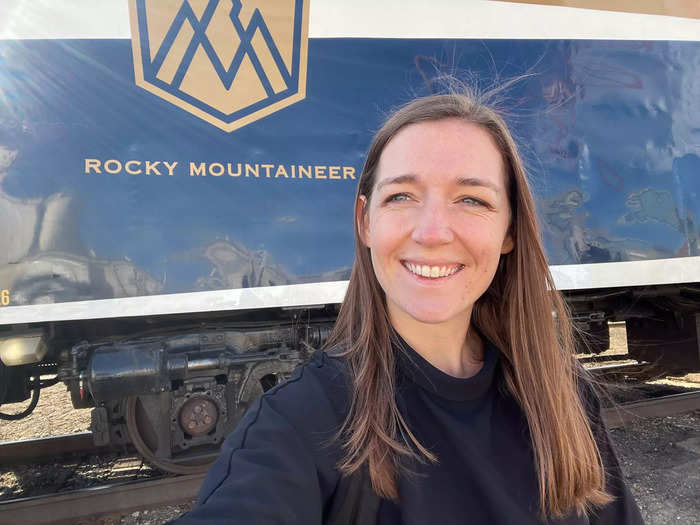
The Rocky Mountaineer has a reputation. It's known for extravagance and breathtaking views.
From CNN to Travel and Leisure, the Canadian railway company has earned a spot on numerous lists highlighting luxury trains.
The company has four train routes, three of which depart from Vancouver and head east. All of Rocky Mountaineer's trains feature glass-dome coaches, and the company advertises "daylight trains," which means that passengers sleep in a hotel each night instead of in train roommettes.
While the price fluctuates based on the journey and time of year — the Rocky Mountaineer runs between spring and fall — the trips cost between $1,465 and $2,342.
Last year, the company launched its fourth route: Rockies to the Red Rocks. As the company's first US route, it's a two-day train journey between Denver, Colorado, and Moab, Utah, with an overnight stop in Glenwood Springs, Colorado. The route runs from May through October.
As a travel reporter, I've spent years dreaming of those picturesque glass-dome windows, and as a new Colorado resident, I couldn't imagine a better backdrop than Colorado's towering mountains and Moab's red rock wonderland.
This May, I traveled on the Rocky Mountaineer, sitting under the glass-dome windows admiring expansive canyons, powerful rivers, and historic tunnels. And with those impressive views came plenty of surprises.
The price was one of the most shocking parts of the entire journey.
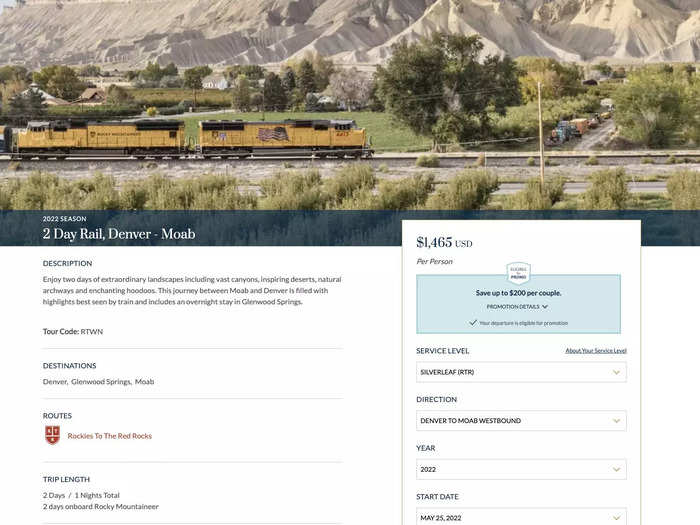
I know luxury comes with a price tag, but I was still startled to learn that a seat on the Rocky Mountaineer costs $1,465 for a solo rider. SilverLeaf Plus, the train's first-class seating, costs a single rider $1,960.
I purchased my ticket on sale, and it cost $1,052. Insider paid for the train per our reporting standards.
In terms of cost per day, the Rocky Mountaineer was the most expensive trip I've taken. A seven-day cruise to the Bahamas cost me $1,288 last summer, and the train was hundreds more than the five-star luxury hotels I've slept in.
The Rocky Mountaineer was also much more expensive than other trains departing from Denver. According to Amtrak's website, a similar journey from Denver to Green River, Utah, which is about an hour north of Moab, costs passengers $122 for coach and about $370 for a private roomette cabin.
But, again, the Rocky Mountaineer is more about the journey rather than just getting to your destination. It's welcomed guests like Bill and Melinda Gates and Reba McEntire, according to the train's brochure, and promises to serve gourmet meals and offer incredible views out the train's expansive windows. .
I wasn't expecting the first sign of luxury: a red carpet rolled out to welcome passengers onto the train.
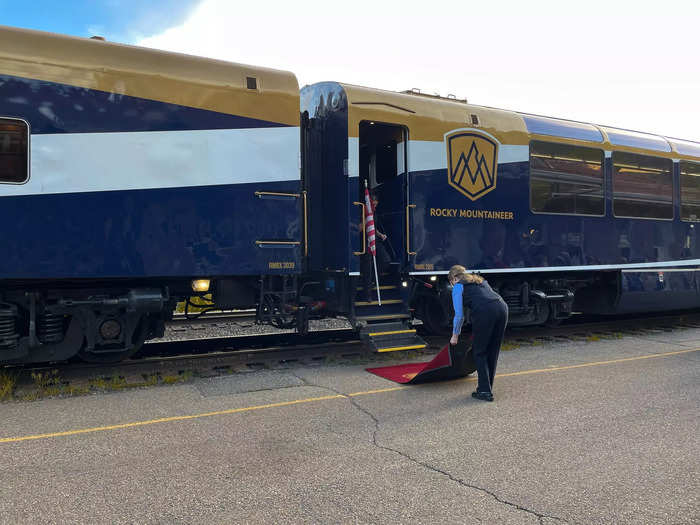
I arrived at Denver's Union Station, the main transportation hub in downtown Denver, only to board a motor-coach bus to head to Denver's RiNo district, where the Rocky Mountaineer train was waiting for passengers.
Once off the bus, train employees bustled around, checking off people's names and helping us navigate to the proper train car.
As I arrived at train car three, a red carpet with the Rocky Mountaineer's logo was sitting out front along with an American flag and Colorado flag.
I noted the royal red and hoped it was an indicator of what was in store for the rest of the journey.
I was surprised to be greeted by a train host and chef, who would be on hand for the two-day journey.
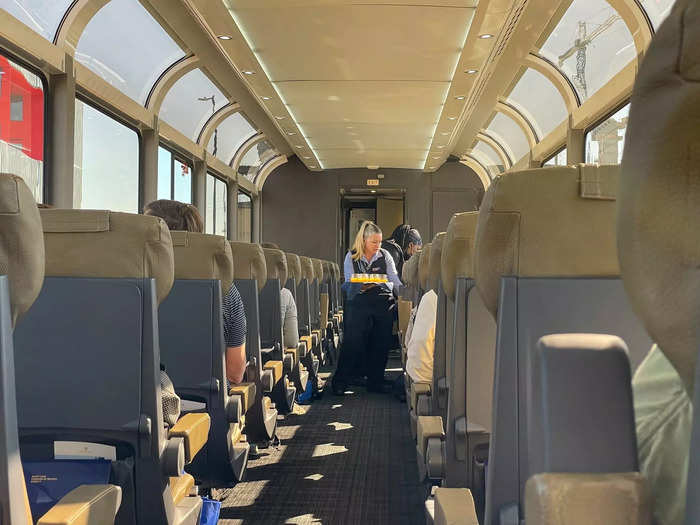
The Rocky Mountaineer has seven passenger cars that each seat about 50 people. For the SilverLeaf service, each train car has its own train host and chef.
Nephi, our chef in train car three, came out to greet us at the start of our journey. For the next two days, she took our food orders, prepared our meals, and helped serve food to passengers.
Christina was our train host. As a host, she helped serve food, poured drinks, relayed messages about the status of our journey, and shared facts about the landmarks along the tracks.
Their service felt personalized. Nephi quickly noted that I don't eat meat, and before every meal, she'd touch base with me on what I could and couldn't have. When there wasn't a vegetarian option available, she hunted one down.
Meanwhile, Christina served as our tour guide, answering questions and joining in on conversations when she had a moment to spare.
Since we saw their faces both days, it helped create a personalized experience for the entire journey that I didn't quite expect.
Each train host curated their own stories and facts to share throughout the journey, which felt like a personal touch.
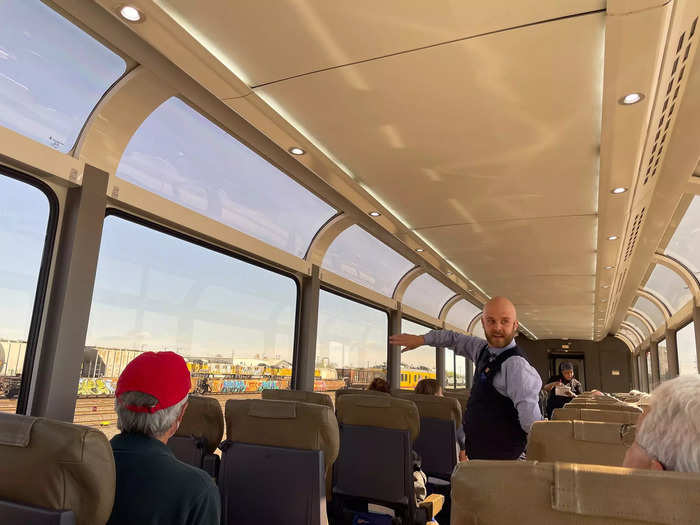
I wasn't expecting anyone on the train to provide insight into where we were traveling, but I was thrilled to learn about local wildlife, famous tunnels, and the tracks the train was rolling on through our train host Christina.
Also on the train was Zach Lucas, one of Rocky Mountaineer's train managers. Part of Zach's job is to help coordinate the train hosts. He told Insider that each host is given a basic skeleton of what to share throughout the two-day journey.
They're expected to dive into the history of nearby passing landmarks like the Moffat Tunnel, which is a 6-mile long tunnel, or Utah's Cisco ghost town. But they're also able to add their own twist, he said.
Zach added that many of the hosts go to local libraries and museums to learn about the history of the west and incorporate it into their own train narratives.
Beyond their own knowledge, the hosts sprinkled in plenty of jokes throughout the ride.
There were a handful of delays — and I was stunned when no one seemed to mind.
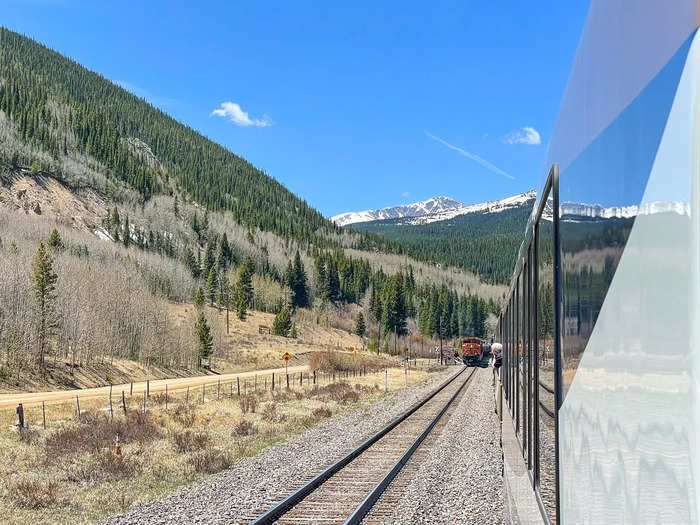
After stepping off the red carpet and into the glass-dome train car, I navigated to my seat. There, I sat and waited.
Shortly after, Zach came bustling through the car announcing that there was a freight train causing a minor delay.
On any plane, an announcement like that likely would've been met with groans and frustration. On the Rocky Mountaineer, there was none of that. Since no one had anywhere to go and sitting on the train was part of the experience, no one seemed inconvenienced by the 20-minute slowdown.
Instead, Christina served orange juice and Nephi poured Prosecco. Some of us gazed at our breakfast menus and contemplated choosing either the parfait or the waffle while others looked out the window into Denver's industrial district.
Later that day, we had two more delays, which ranged from 15 to 30 minutes. But again, no one seemed fazed by the delays.
I didn't expect much legroom. However, I was thankful I could stretch my limbs and was shocked I wasn't aching after 15 hours on the train.
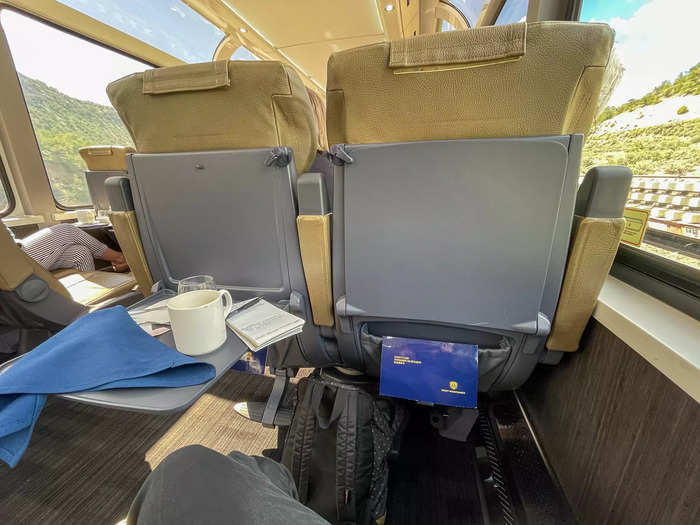
My typical train journey is a 40-minute ride on Denver's commuter train to the Denver International Airport.
And if I'm flying during peak travel hours, I always expect a person sitting next to me in a cramped row of seats. Typically, my backpack and suitcase are squished on my lap and between my legs.
The seats on Rocky Mountaineer were far from my commuter train or typical flying experience.
In my row, I had plenty of room to store my backpack and stretch out. Each seat reclined a bit, which naturally moved my eyesight skyward toward the glass-dome ceilings. I could tell the seats were thoughtfully designed for relaxation instead of commuting.
It was by no means as comfortable as my couch at home. But after spending 15 hours on the train, I noticed no aches, which I usually feel after a much shorter flight in economy class.
I envisioned stepping into a full train car. Instead, it was quite empty.
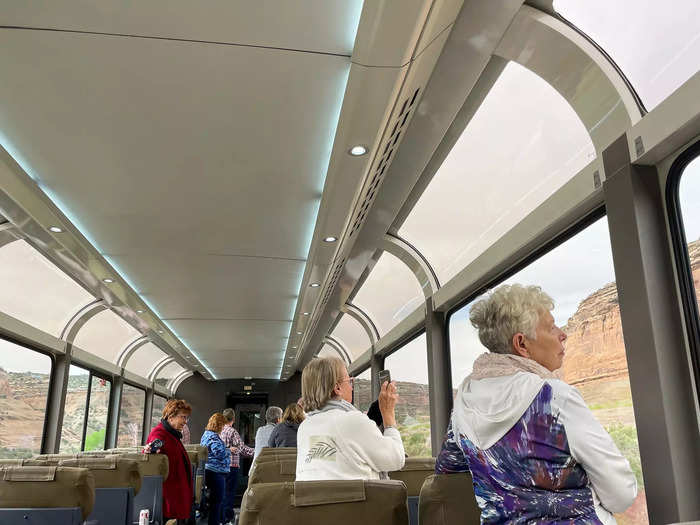
My train, which left on May 15, was still considered early in the season. Christina said we were lucky, and that she expected every seat to be occupied in just a few weeks when summer officially started. She guessed that the crowds would likely continue into the fall.
For my trip, the Rocky Mountaineer had fewer train cars attached, and only about half the seats were occupied.
The emptier car allowed the passengers to move around more easily than I imagine they would if it was completely full. If something exciting was happening — like a bald eagle flying or people rafting down the Colorado River — we could all move and look out the nearest windows.
From welcome mimosas to 11 a.m. cocktails, there was no shortage of alcohol.

On day one, the Rocky Mountaineer team welcomed us with mimosas. Shortly after breakfast, Christina came around with a beverage cart, offering wine, beer, and spirits. After lunch, there was another drink break.
If there was a moment when your drink was empty, all you had to do was flag Christina and she'd get you whatever you'd like.
One of the main differences between service levels on the train was the type of drink you could order — Christina only had mixers, liquor, beer, and wine for my cabin, while first-class had a fully stocked bar — but no one seemed to hold back on beverages.
I didn't know that there would be no cell service for the bulk of the journey.
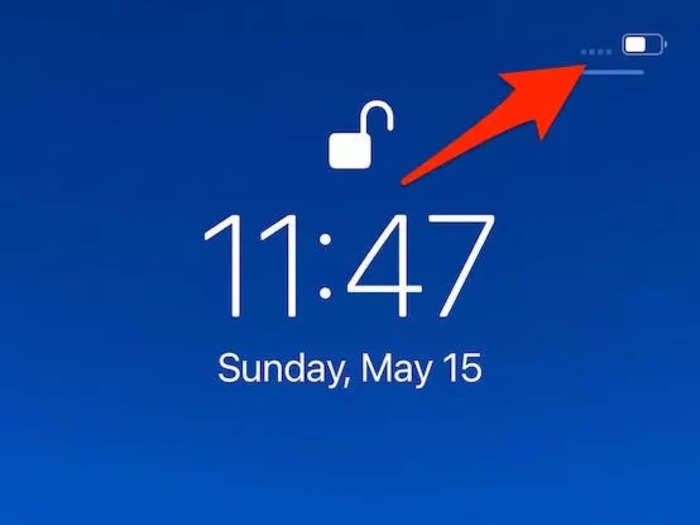
After living in Colorado for a year, I've learned that you can't expect cell service in mountainous areas. From experience, the moment your car starts climbing up the switchback mountain roads, texts stop sending and Spotify stops playing.
When I boarded the Rocky Mountaineer, I assumed luxury meant some sort of guaranteed cell service or Wi-Fi. I was wrong.
The train didn't have Wi-Fi, and since we were in remote areas for huge portions of the trip, there wasn't cell service either.
I was shocked by how slowly the train moved. What would've been a five-hour drive took 15 hours over the span of two days.
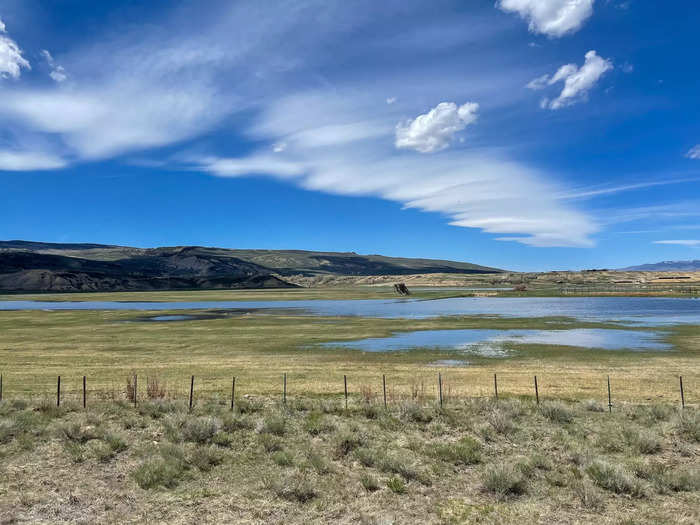
I knew the journey would take longer than a car, but I was surprised by just how much longer.
While I barrel down Interstate 70 going 75 miles per hour in my car, the Rocky Mountaineer reaches an average of 35 miles an hour, according to the train's brochure.
It was a slow journey, and with that slow speed, we spent 15 hours in total on the train. The intent, of course, was to focus on the scenery.
Even with all that time, I was surprised that I didn't get bored.
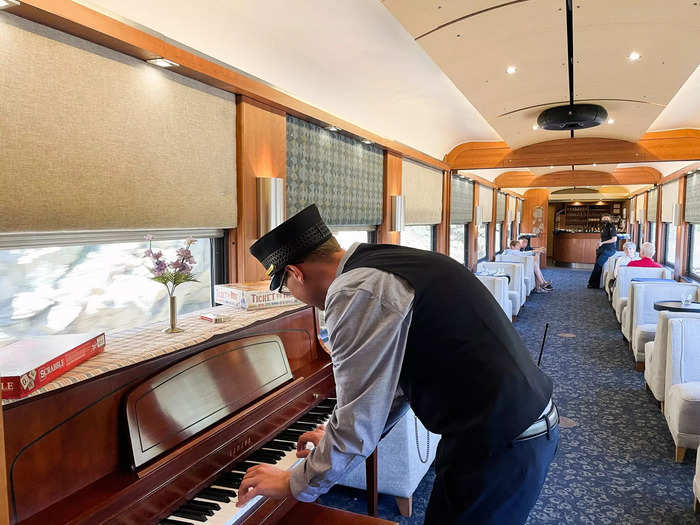
When I stepped into the glass-dome train and landed on seat nine at the very back of the car, I was acutely aware that I'd be spending the next two days in this seat.
I didn't bring any card games, I didn't have a book, and I failed to download Hulu movies on my phone before the journey.
I wondered if I'd sorely regret my lack of distractions. Shockingly, the answer was no.
Between the varying views outside, a constant flow of food and drinks, and seatmates who were eager to chat, I never once got bored.
Sure, I'd probably pack a book next time in case I wasn't in a chatty train car, but overall, I didn't find myself ever itching to get off the train.
I didn't realize that I was expected to tip.
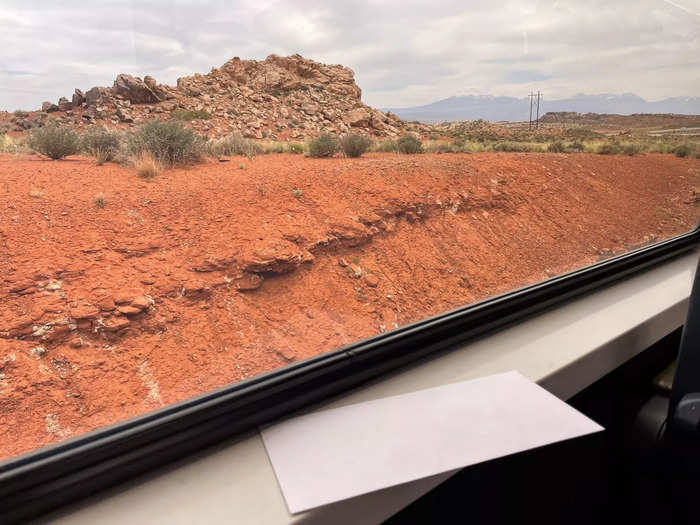
I boarded the train unsure of what the standard for tipping would be. I tipped my cruise ship attendants before, but I've never tipped a flight attendant. So I was surprised to see the practice take place on the train.
A brochure onboard the Rocky Mountaineer, however, outlined the standards.
"Gratuities are at your discretion," the brochure reads. "Our past guests have left gratuities based on their overall service experience ranging from $45 per guest for SilverLeaf, and $55 per guest for SilverLeaf Plus."
After seeing how much they worked for the two days, it made sense, and luckily, I packed cash for the trip. Although the train hosts also said they accepted credit cards, too.
For the most part, the train ride was surprisingly smooth.

After reading my colleague Joey Hadden's coverage of her Amtrak rides across the East Coast, I expected a rocky ride and contemplated packing Dramamine or some sort of motion-sickness medicine.
Luckily, that wasn't the case for me; I thought most of the journey was smooth with a little swaying here and there.
Naturally, we hit some rough patches, but they never seemed to last long, and all the passengers around me agreed that they were shocked by how calm the entire train ride was. Likely, it was because of how slow the train moved, according to a paper published by ASME Conference on Engineering Systems Design and Analysis in 2008.
Finally, I wasn't expecting to get mooned so much.
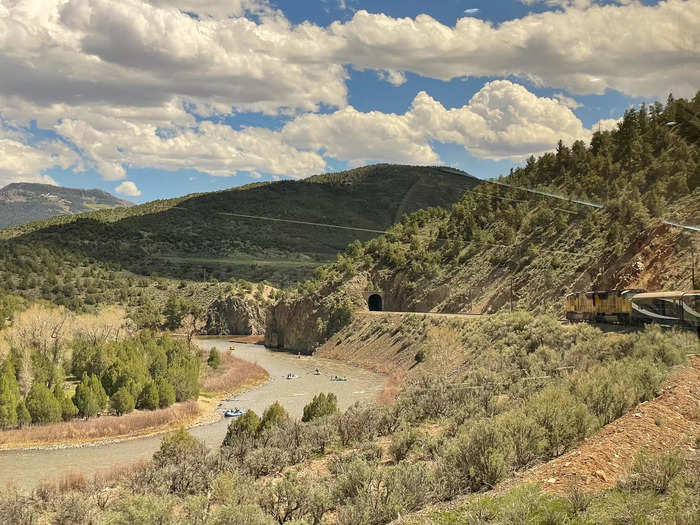
A large section of the Rockies to red rocks route follows the Colorado River, which is one of the state's most popular rafting routes, according to Uncover Colorado.
The rafting route is full of history and tradition, with one being its nickname, Moon River.
As the train barrels down the tracks, rafters from below have been known to moon the trains passing by.
And sure enough, I saw plenty of butts. Christina told our car that a rider on the last journey counted 63 butts.
Luckily, my car seemed to get a great laugh from the rafters.
While some of the surprises about the Rocky Mountaineer were rooted in luxury, others were simply shocking things I learned about train travel.
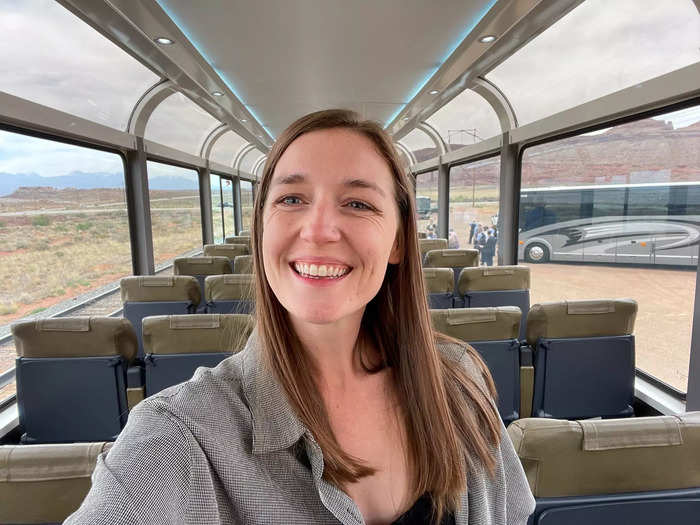
The Rocky Mountaineer promised delicious meals, optimal service, and grand views.
As I stepped off the train onto a red carpet and then onto a red dirt road in Moab, I realized that the two-day journey held up to its promise.
READ MORE ARTICLES ON
Popular Right Now
Popular Keywords
Advertisement